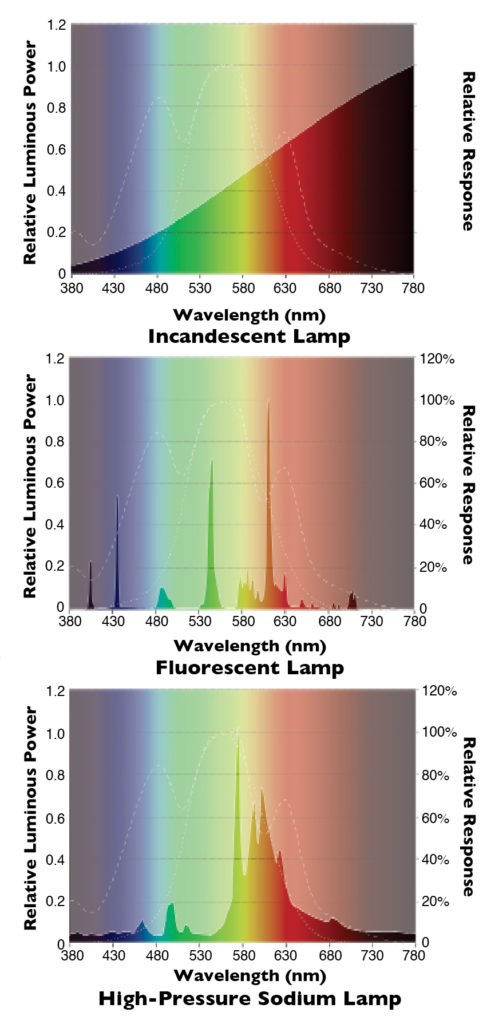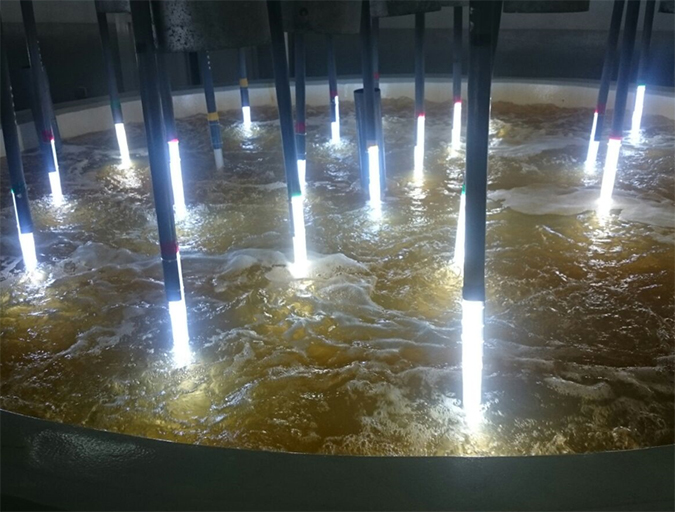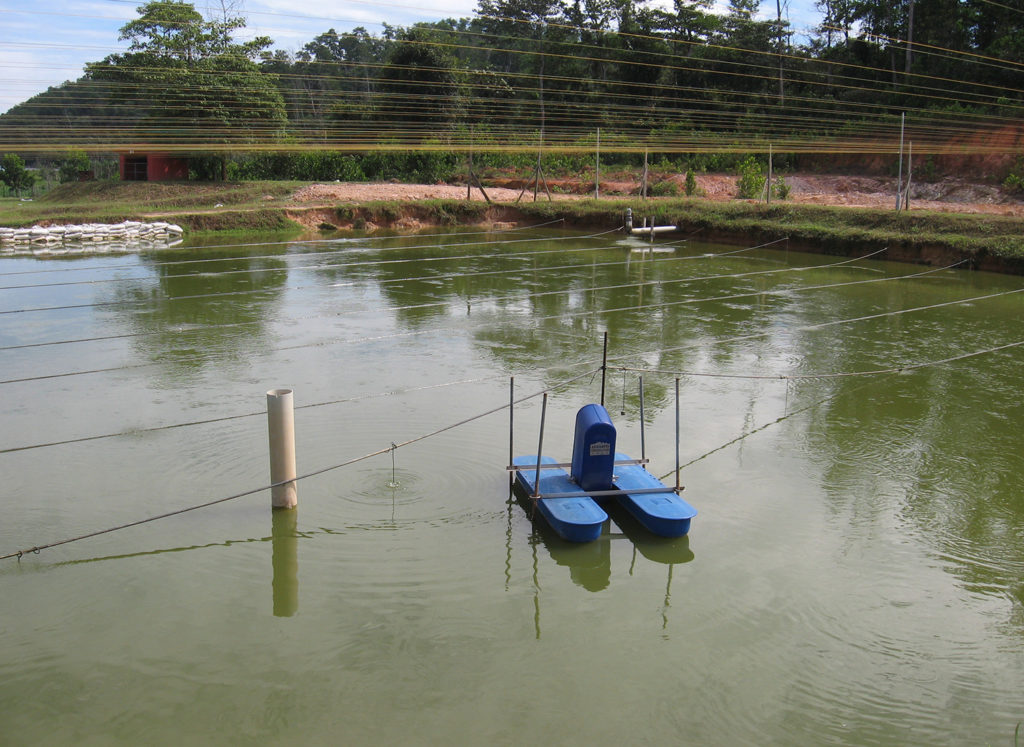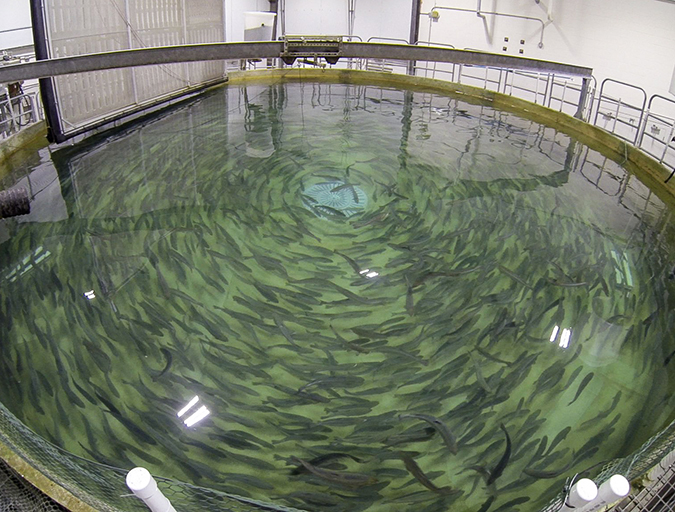Lighting systems should promote animal well-being by reducing stress

Research with fish has shown that environmental light synchronizes all stages of life, from embryo development to sexual maturation. In nature, light rhythms occur in a predictable unfaltering pattern – a pattern that has not changed for thousands of years. Thus, light, not temperature, has been the steadiest of environmental influences in animal evolution. Fish respond to changes in temperature, but they are cued by changes in light.
In nature, light intensity gradually increases during the day and slowly decreases toward sunset. The quality of the light also changes during the day. Sunrise is characterized by a dominance of red light, high noon has a lot of blue color light, and gradually the light color changes to a dominant red again at sunset.
Due to the earth’s changing orientation to the sun, the quantity and quality of light change on a seasonal basis, as well as a diurnal pattern. Furthermore, the quantity and color of light an animal experiences in nature are governed by its geographical location.
Animals’ perception of light
Fish have adapted to the changes in light in their natural environment by evolving a biological clock that is synchronized and driven by light stimuli from their environment. This clock entrains physiological and behavioral processes. On a daily basis, these cyclic processes are known as circadian rhythms, and scientists refer to a “circadian clock” within an organism.
In fish, circadian rhythms are controlled mainly by the release of hormones and establish times of sleeping, eating, movement and socialization. Light in an animal’s environment also entrains on a seasonal cycle. Migration and reproduction are two processes that are highly regulated by seasonal light.
In humans, the main structure for photoreception is the eye, but many vertebrates have other structures, separate from retinal receptors, that monitor and respond to light in the environment. These structures are known as extra-retinal photoreceptors. In teleosts, the pineal gland and deep-brain photoreceptors are examples of these structures.
Research has shown that in fish, these structures can become functionally responsive to light before retinal photoreceptors develop and before the animal is born. In the zebra fish, the developing embryo is photo stimulated in the first day post-fertilization, long before the development of the eye. The eggs of Atlantic halibut are photosensitive before hatch, allowing aquaculturists to synchronize the hatch time of the eggs by manipulating lighting conditions.

Lighting: a tool in aquaculture
In recent years, there has been a push to move more and more of the growing and reproduction of aquatic animals onshore and indoors into highly controlled environments. Situationally, when animals are reared in closed environments, the lighting they receive is more likely to be dominated by artificial light sources.
Traditionally, artificial light sources in aquaculture have been incandescent, fluorescent or metal halide bulbs. Unfortunately, these artificial light sources are very limited in their ability to simulate natural environmental light and therefore do not provide optimum rearing conditions for animals under culture.
In general, incandescent bulbs emit light with predominantly red wavelengths. Compact fluorescent lamps emit blue/green wavelengths, and high-pressure sodium lamps emit in the yellow/green range.
All of these light sources come in different, but usually fixed, intensities and fixed wavelengths, so once the choice of lamp has been made, the environmental light spectrum and intensity are also fixed. Dimming systems can be used with a few of these lighting systems, but the dimming capabilities are limited both in intensity and spectral range.
LED technology
A light-emitting diode (LED) light is comprised of one or more solid-state devices that convert electrical energy directly into light through a process called electroluminescence. The emitted light is usually blue or violet, but by passing it through a phosphor material, it can be modified to produce a broad spectrum of other colors.
The result can be a range of “white” light correlated with the full spectrum of natural sunlight and beyond. An LED lamp is basically a series of solid-state chips, and because of this, a wide range of control can easily be applied to the lamp to change both its intensity and spectrum.
Light intensity, color
The perception of environmental light is very different for fish than for humans because of different light-sensitive structures in the eyes of fish and different structures in their bodies. When it comes to vision, humans are considered trichromatic, which means we see three colors – red, blue and green – with the cones in our eyes. Most fish can see color, but not all can distinguish the full color spectrum.
For example, bass have excellent color vision in clear, bright conditions, while walleye can only detect oranges and greens, with all other colors appearing as shades of gray. Many predator fish can also see into the ultraviolet spectral range.
The eyes of rainbow trout are sensitive to four different wavelengths. The retinal rods contain a visual pigment with maximum wavelength sensitivity at 512 nanometers (nm), a green color to humans. The retinal cone systems in adult trout consist of single and double cones with pigments having peaks at 453, 530 and 598 nm.
Zebra fish have a dark-adapted visual system that can be influenced by water temperatures. These fish have two spectral sensitivities, one when the water is “warm” (28 to 30 degrees C) and another when the water is “cold” (22 to 25 degrees C). Ultraviolet cones in the eyes of zebra fish contribute to the animals’ dark-adapted spectral sensitivity under both temperatures.
Some fish, like the walleye, have a tapetum lucidum, a structure on their retina that creates a reflective eye, similar to nocturnal land animals. This structure bounces light that has already passed the rods back for a second chance at detection. The fish’s sight is very slightly blurred, but very light sensitive.
The fact that some species of fish have reflective eye structures can create problems in aquaculture when the fish are moved from low-light conditions to those with higher light intensities. Transfer without consideration of the changes in environmental light can shock the fish and cause them to become disoriented.
LED lighting design
Energy savings are substantial with the use of LED lighting technology in indoor aquaculture operations. A farmer switching to an LED light source can reduce electrical energy use by 60 percent, while maintaining the same lighting intensity received from traditional light sources.
When considering transitioning to an LED-based lighting system, several factors are key to achieving an optimum lighting environment for fish.
First, choose the lamp wisely. Look for an LED lamp made for aquaculture applications, not just household use. An indoor aquaculture lamp must be robust and able to withstand the high humidity found in aquaculture environments. If used in a marine fish operation, lamps should also be able to withstand the corrosive effects of salt. A good aquaculture lamp will have a guaranteed life span of operation under aquaculture conditions.
Second, a properly designed lighting system should deliver uniformity of light across the water’s surface in rearing tanks. The lighting system should be designed with animal lighting needs as the first priority, and human activity lighting needs secondary.
Unfortunately, it is common to see variability in light delivery in indoor aquaculture facilities, with some tanks receiving one mixture of wavelength and intensity of light, and others receiving a different mixture of wavelength and intensity. Yet the reasons for “tank differences” are rarely associated with variances in environmental lighting. A properly designed lighting system supports the aquaculturist’s goal of narrow grades of harvest animals with consistency in presentation.
Third, an LED lighting system must have versatility and not deliver only a single option of output. Natural light changes during the day, both in light intensity and light color. An indoor lighting system should be able to mimic the important light parameters for the animals under culture – not only photoperiod, but also color of light and intensity.
Most importantly, a lighting system should promote animal well-being by reducing stress. This can be as simple as programming a daily sunrise and sunset into the lighting treatment. However, much greater benefit can be achieved if the daily lighting treatment is in synchrony with the fishes’ visual needs and cues for feeding, socializing and distribution in the tank.
(Editor’s Note: This article was originally published in the July/August 2015 print edition of the Global Aquaculture Advocate.)
Author
-
Dr. Juliette Delabbio
Director of Research and Development
Once Innovations Inc.
5455 Highway 169 North
Plymouth, Minnesota, USA 55442[109,111,99,46,115,110,111,105,116,97,118,111,110,110,105,101,99,110,111,64,111,105,98,98,97,108,101,100,106]
Tagged With
Related Posts

Aquafeeds
Novel light bank reactor aids in microalgae culture
The control of temperature and light intensity in microalgae culture in outdoor tanks is difficult. Progress in algal biotechnology and the use of photo-bioreactors, metabolic engineering and other advances supported development of a novel underwater light bank reactor that allows for more effective light utilization by cultured microalgae.

Health & Welfare
A study of Zoea-2 Syndrome in hatcheries in India, part 1
Indian shrimp hatcheries have experienced larval mortality in the zoea-2 stage, with molt deterioration and resulting in heavy mortality. Authors investigated the problem holistically.

Health & Welfare
Advice for managing predatory birds, part 1
Predatory birds can cause major losses for tilapia farms. As some bird species are protected by law, fish farmers must use non-lethal control techniques.

Innovation & Investment
Getting proficient in RAS fundamentals
A number of large salmon farming companies are now investing significantly to increase land-based, water recirculating aquaculture systems (RAS) in northern Europe and North America, and there is likely a need for more trained farm personnel to run and manage these and other close-containment aquaculture facilities.


